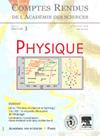石墨烯外延生长的二氧化硅单层中锰掺杂的研究
IF 1.2
4区 物理与天体物理
Q3 ASTRONOMY & ASTROPHYSICS
引用次数: 3
摘要
在二维(2D)材料中引入磁性代表了当今研究的一个激烈领域,追求达到室温以上的有序温度仍在进行中。2017年,在低居里温度下,发现了CrI3和Cr2Ge2Te6的单层本征铁磁性。将磁性引入传统二维材料的另一种方法是类似于三维稀释磁性半导体的磁性杂质的替代掺杂。掺杂锰的过渡金属二硫化物(MoS2, MoSe2, WS2, WSe2)单层是非常有趣的,因为结合了面外铁磁性和谷对比导致了铁谷材料。在这项工作中,我们重点研究了在石墨烯上通过分子束外延将Mn掺入到MoSe2中,这一问题目前很少得到解决。通过使用多尺度表征方法,我们证明Mn原子被纳入MoSe2单层高达5个原子百分比。然而,当加入到薄膜中时,Mn原子倾向于扩散到晶粒边缘,在MoSe2单层完成后,在晶界处形成未定义的MoxMnySez相。这种分离使MoSe2的晶体和电子结构未被改变。在5%以上,MoSe2中Mn含量的饱和导致外延MnSe簇的形成。本文章由计算机程序翻译,如有差异,请以英文原文为准。
The search for manganese incorporation in MoSe 2 monolayer epitaxially grown on graphene
The introduction of magnetism in two-dimensional (2D) materials represents an intense field of research nowadays and the quest to reach above-room-temperature ordering temperatures is still underway. Intrinsic ferromagnetism was discovered in 2017 in CrI3 and Cr2Ge2Te6 in the monolayer form with low Curie temperatures. An alternative method to introduce magnetism into conventional 2D materials is substitutional doping with magnetic impurities similarly to three-dimensional diluted magnetic semiconductors. The case of Mn-doped transition metal dichalcogenide (MoS2, MoSe2, WS2, WSe2) monolayers is very interesting because combining out-of-plane ferromagnetism and valley contrast leads to ferrovalley materials. In this work, we focus on the incorporation of Mn in MoSe2 by molecular beam epitaxy on graphene which has been rarely addressed up to now. By using a multiscale characterization approach, we demonstrate that Mn atoms are incorporated into the MoSe2 monolayer up to 5 atomic percent. However, when incorporated into the film, Mn atoms tend to diffuse to the grain edges forming undefined MoxMnySez phase at grain boundaries after completion of the MoSe2 monolayer. This segregation leaves the crystalline and electronic structure of MoSe2 unmodified. Above 5%, the saturation of Mn content in MoSe2 leads to the formation of epitaxial MnSe clusters.
求助全文
通过发布文献求助,成功后即可免费获取论文全文。
去求助
来源期刊

Comptes Rendus Physique
物理-天文与天体物理
CiteScore
2.80
自引率
0.00%
发文量
13
审稿时长
17.2 weeks
期刊介绍:
The Comptes Rendus - Physique are an open acess and peer-reviewed electronic scientific journal publishing original research article. It is one of seven journals published by the Académie des sciences.
Its objective is to enable researchers to quickly share their work with the international scientific community.
The Comptes Rendus - Physique also publish journal articles, thematic issues and articles on the history of the Académie des sciences and its current scientific activity.
From 2020 onwards, the journal''s policy is based on a diamond open access model: no fees are charged to authors to publish or to readers to access articles. Thus, articles are accessible immediately, free of charge and permanently after publication.
The Comptes Rendus - Physique (8 issues per year) cover all fields of physics and astrophysics and propose dossiers. Thanks to this formula, readers of physics and astrophysics will find, in each issue, the presentation of a subject in particularly rapid development. The authors are chosen from among the most active researchers in the field and each file is coordinated by a guest editor, ensuring that the most recent and significant results are taken into account. In order to preserve the historical purpose of the Comptes Rendus, these issues also leave room for the usual notes and clarifications. The articles are written mainly in English.
 求助内容:
求助内容: 应助结果提醒方式:
应助结果提醒方式:


